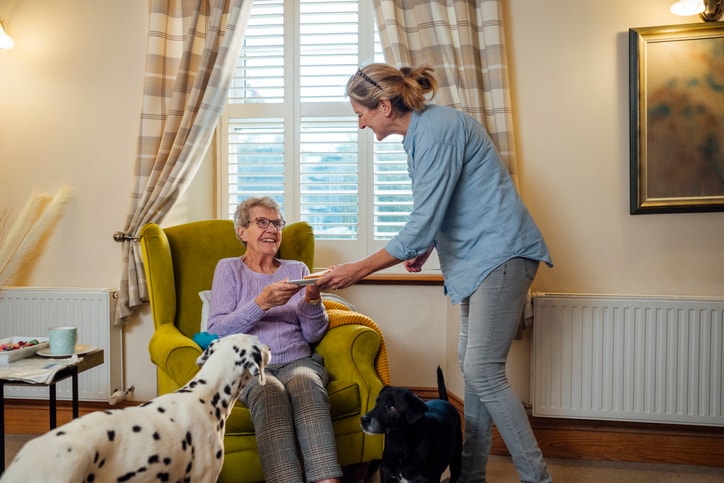In this article
Chances are you’ve been through a period in your life when things didn’t feel “quite right.” Maybe you had an awkward social interaction with the barista, felt overly fixated on something going wrong at work or even had a general sense you didn’t quite fit in in certain social settings. Of course, there’s a chance this was a fluke — a momentary feeling of awkwardness, anxiousness or alienation that pegs nearly all adults on occasion. But for many older adults, an actual undiagnosed condition was at play the entire time: autism.
According to the most recent data from the Centers of Disease Control Prevention (CDC), an estimated 5,437,988, or 2.21%, of American adults have been diagnosed with autism. And according to Ann Carrick, communications manager at the Madison House Autism Foundation, an organization that focuses on improving the health and wellbeing of adults on the spectrum, that number is rising.
“It is becoming more common for adults to get a diagnosis,” she says. “Testing has gotten better and more accessible over the years, which is part of the reason why the prevalence rate has been steadily increasing. Additionally, more people are being diagnosed with autism, whereas in past years they may have thought it was another condition.”
Here’s why autism is diagnosed later in life for some, what autism in older adults means and how caregivers can help.
Key takeaways
- Undiagnosed autism in older adults is common due to masking and misdiagnosis.
- A later-life diagnosis improves mental health and access to support.
- Caregivers should focus on individual needs, safety, and available resources.
Undiagnosed autism in older adults: Why this might happen?
James Giordano, a professor of neurology at Georgetown University Medical Center, notes that late (or completely absent) autism diagnoses happen for a myriad of reasons, but one of the main ones is lack of research.
Much of the focus surrounding autism is in children, with only an estimated 1-2% of funding for autism studies geared toward adults. (So, naturally, this means how symptoms manifest in adults is much less-discussed and observed than in children.)
That said, the uptick in overall autism research and diagnoses is trickling down to older adults. “As more individuals are being diagnosed and awareness and acceptance has increased, I have seen an increase in those diagnosed as an adult,” says Emily Newton, a clinical psychologist and board certified behavior analyst at Springtide Child Development. “Additionally, when I do diagnostics with children, I often have parents share that they believe they also have a diagnosis due to similar behaviors of their child they see in themselves.”
“When I do diagnostics with children, I often have parents share that they believe they also have a diagnosis due to similar behaviors of their child they see in themselves.”
— Emily Newton, clinical psychologist and behavior analyst
Another reason autism in older adults can go unnoticed is that the person has become adept at “masking” it. Studies have shown that women in particular will often work extra hard to hide their autistic traits in social situations. Others might not pursue getting a diagnosis in childhood (due to their parents) or adulthood because of the stigma alone, says Giordano. “In some cases, individuals might conceal their autism to avoid stigma or bias at school, work and in interpersonal relationships.”
And even if a person with autism who’s undiagnosed does get the chance to see a physician, many doctors are only trained to recognize symptoms most commonly found in children, as much of the research is child-centric, notes the American Psychiatric Association. And because of this, autism may be confused with other conditions.
“Those with social anxiety or ADHD may demonstrate symptoms similar to those with autism,” Newton notes. “Due to this, it is important diagnoses occur from a trained clinician.” Historically, schizophrenia has also been confused with autism in older adults.
And finally, a later-in-life diagnosis is more “nuanced” that those in kids, notes Newton — particularly if the person has been masking it. “Instead of symptoms being observed in the moment,” she says, “they may have been present in early years and then have to be reported by the individual.”
What a positive autism diagnosis can do for older adults
Without a diagnosis, an older adult with autism is at risk for a number of conditions, one of which is a considerable dive in mental health. A study from the Journal of Autism and Developmental Disorders, which surveyed 420 autistic adults, found that those diagnosed later in life self-reported overall poor mental health and that their autistic symptoms had steadily worsened over the years.
What’s more, autistic people are 2.5 times more likely to die earlier than their non-autistic peers and also face higher likelihoods of heart disease, diabetes and more.
But more adults are getting diagnosed, which is giving them access to the help and support they need to thrive. “I advocate for diagnoses as a way to access services or to have a better understanding of what you are experiencing,” Newton says. “In both these ways, diagnoses at any age are beneficial.” However, she adds, services for older adults with autism may be “more difficult to find.”
How caregivers can support older adults with autism
In terms of common behaviors and challenges that come with autism in older adults, it’s helpful to know more about what the autism spectrum looks like, Carrick says.
“Many people think of the spectrum as a straight line, but it’s actually more like a circle with ‘pie pieces,'” she explains. “Each pie piece is a common type of challenge area, like sensory processing or motor coordination or social difficulty, among others. Each person has a dot somewhere in each section, so one person may have high support needs with sensory processing, but have no problem at all socializing with others. Another person may have a lot more trouble with socializing but have minimal trouble with sensory integration or motor control.”
“Many people think of the spectrum as a straight line, but it’s actually more like a circle with ‘pie pieces.'”
— Ann Carrick, communications manager, Madison House Autism Foundation
“It really depends on the person and their unique set of challenges and abilities,” continues Carrick. “This is why it’s important to find services that are person-centered and focus on each individual’s unique challenges.”
Put another way: No autism diagnosis or treatment is one-size-fits-all. That said, here are some symptoms that may present with autism, along with how to support.
1. Learn where on the spectrum the person you’re caring for falls
Autism, again, can present itself in a wide range of ways, with some symptoms being hardly noticeable. As Giordano and Carrick stress, understanding how the symptoms of the person you’re caring for manifest is paramount in keeping them happy and healthy.
Are they overwhelmed in crowded spaces? Visit certain public spaces, like the grocery store, off-hours. Is the person you’re caring for particularly social-averse (despite a doctor recommendation to get out and make friends)? Look into an autism-specific support group that supports socialization can help. (More on that below.)
2. Have a safety plan in place
In many cases, an older adult with autism can live a relatively normal life. But in cases where the the individual needs a lot of support, having a safety plan in place is paramount. Wandering is a safety risk that affects both children and older adults with autism. Additionally, wandering can affect older adults, with or without autism, that have dementia or Alzheimer’s (and the two conditions can co-exist [in fact, folks with autism are more likely develop Alzheimer’s.]).
There are a number of ways to both prevent and deal with wandering in older adults, including:
- Keeping a routine.
- Keeping track of the times a loved one tends to wander.
- Avoiding busy places.
- Using a GPS tracking device.
- Keeping copies of their photo to quickly alert police, neighbors and first responders.
3. Help them tap into eligible government resources
An official autism diagnosis means that the person diagnosed becomes eligible for certain supports, services and protection under the law. One option is the Americans with Disabilities Act (ADA), which gives access to reasonable accommodations at work and school and protection against discrimination.
Older adults can also tap into Medicaid, which can help pay for residential habilitation and health home aides. Here’s how to get started.
4. Help protect them from scams
Older adults in general are more prone to scams and that applies even more to adults with autism, notes Newton.
“Individuals on the spectrum who are socially motivated may be susceptible to inappropriate influence by others who do not have the best intentions,” she explains. “It is important for those who are high school age and older to have a strong understanding of positive relationships, such as friendships or romantic relationships. Peer education groups or social skills groups can be really beneficial to help teach about safe relationships and positive friendships.”
5. Lean on resources for support and knowledge
As a caregiver for an older adult who has autism, one of the most impactful ways you can improve their life is through connection to various health and social resources. Here are a few, all of which offer support groups, education tools and more:





